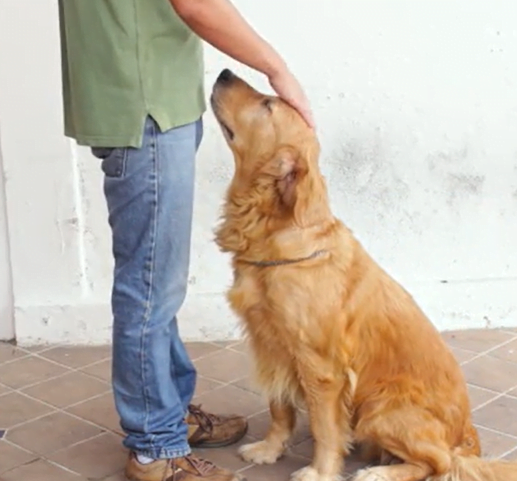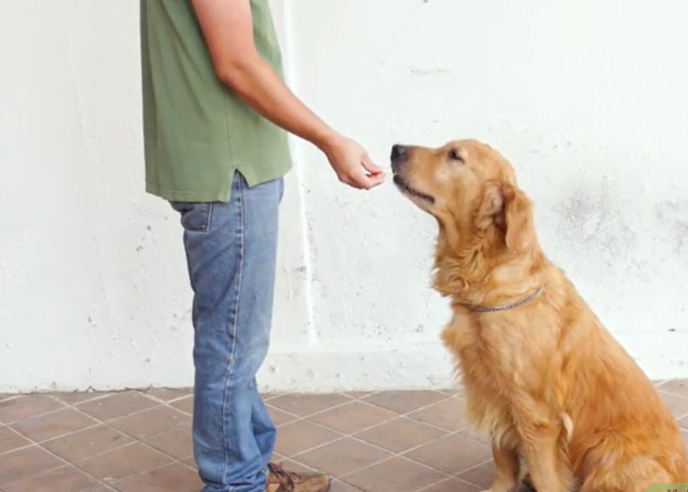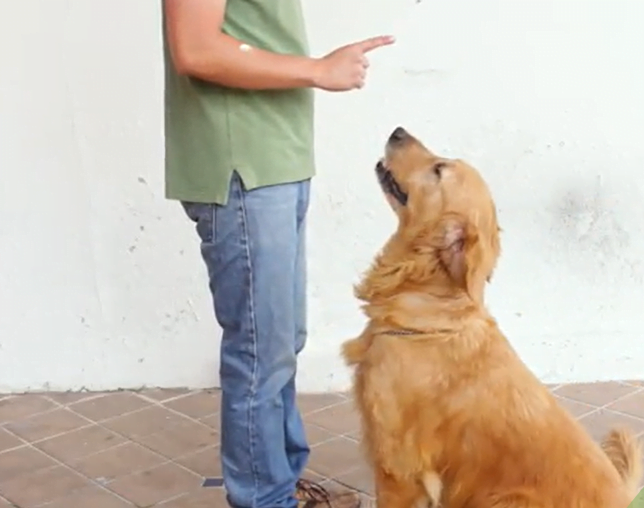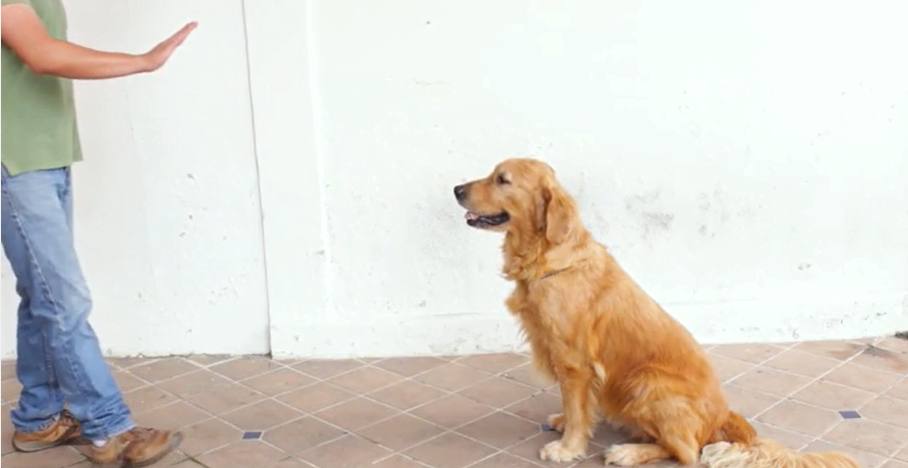Das Ziel, Ihrem Hund zu unterrichten, „zu bleiben“, ist so, dass er in einer bestimmten Position bleibt, bis Sie zu ihnen zurückkehren. Dies kann a sein nützliches Verhalten Um Ihrem Hund zu jeder Zeit beizubringen, wenn Sie ihn brauchen, um beispielsweise an einem bestimmten Ort zu bleiben, um sie während des Gartens oder Kochens aus dem Weg zu halten!
Dies kann eine herausfordernde Sache für Hunde sein, da wir sie bitten, über einen längeren Zeitraum in einiger Entfernung von uns zu bleiben, unabhängig von den Ablenkungen. Das ist schwierig zu tun, besonders wenn wir so viel Zeit mit unseren Hunden verbringen und ihnen beibringen, zu uns zu kommen und uns aufmerksam zu machen, wenn wir fragen!
Aber jeder Hund kann lernen, an einem Ort zu bleiben, besonders wenn das Training immer Spaß macht und lohnend ist. Wir machen das von Verwendung von Belohnungsbasis und nur sehr allmählich voranschreiten, damit unsere Hunde in jeder Phase zuversichtlich sein können….
Stellen Sie Ihren Hund für den Erfolg ein, indem Sie zunächst an einem ruhigen Ort wie Ihrem Haus oder Garten trainieren. Bitten Sie Ihren Hund zu sitzen (oder legen Sie sich hin, wenn dies für sie einfacher oder komfortabler ist) und belohnen Sie sie dann sofort mit einem Leckerbissen. Ermutigen Sie sie, wieder aufzustehen, und wiederholen Sie dann. In dieser Stufe wird sie für die Position belohnt, in der Sie schließlich bleiben möchten, wenn Sie sich von ihnen entfernen.
Bitten Sie Ihren Hund, zu sitzen und eine Sekunde zu warten, bevor Sie ihn mit einem Genuss belohnen. Dann ermutigen Sie sie, sich zu bewegen und eine kurze Pause einzulegen, bevor sie sich wiederholen. Bauen Sie nach und nach die Zeit zwischen ihnen auf, sie zu setzen und sie zu belohnen, bis Ihr Hund fünf Sekunden lang still sitzen kann. Zu diesem Zeitpunkt stehen Sie immer noch direkt neben ihnen!

Jetzt können Sie das Wort "Stay" hinzufügen. Bitten Sie Ihren Hund zu sitzen, sagen Sie dann „Bleiben Sie“ und warten Sie fünf Sekunden, bevor Sie ihn mit einem Genuss belohnt. Dann ermutigen Sie sie, sich zu entfernen und eine kurze Pause einzulegen. Sagen Sie nur einmal "Bleiben". Wiederholen Sie sich nicht, wenn Sie möchten, dass Ihr Hund nach nur einem Fragen zuhören kann!

Bauen Sie allmählich weiter auf die Zeit, in der Ihr Hund still sitzt. Sobald Ihr Hund 10 Sekunden lang still sitzen kann, bitten Sie ihn, sie still zu bleiben, bevor Sie sie völlig unvorhersehbar belohnen! Fragen Sie zum Beispiel drei Sekunden, bevor Sie sie belohnen, und lassen Sie sie dann vier Sekunden vor der Belohnung, dann zwei, dann fünf, dann acht… und so weiter! Dies bedeutet, dass Ihr Hund nicht vorhersagen kann, wie lange Sie sie benötigen, um still zu bleiben. Daher sollten er sich erst darauf vorbereiten, sich zu bewegen, bis Sie es klar gemacht haben, indem Sie zu ihnen zurückkehren und sie belohnen.
Wenn Ihr Hund aufsteht, bevor Sie sie belohnt haben, kann dies bedeuten, dass die Zeit, in der Sie ihn bitten, zu diesem Zeitpunkt still zu bleiben, oder Sie haben zu lange trainiert und sie sind müde oder langweilen. Gehen Sie zurück zu einigen kürzeren Aufenthalten, beenden Sie die Sitzung oder machen Sie etwas Einfaches, das Ihr Hund gut kennt und kann richtig werden! Bleib positiv! Zeigen Sie Ihrem Hund, dass Sie unglücklich sind, kann ihn verwirren und sich Sorgen machen.

Bitten Sie Ihren Hund, zu sitzen und zu bleiben. Lehnen Sie sich einfach leicht zur Seite, weg von ihnen, um sie daran zu gewöhnen, dass Sie Ihren Körper von ihnen wegbewegen. Gehen Sie zurück zu Ihrer Ausgangsposition und belohnen Sie sie. Ermutigen Sie sie, aufzustehen und sich für eine kurze Pause zu bewegen, und wiederholen Sie dann.
Bitten Sie Ihren Hund als nächstes, zu sitzen und zu bleiben und sich diesmal einen Schritt zur Seite zu bewegen. Kehren Sie dann zu Ihrem Hund zurück und belohnen Sie sie, wenn sie sich weitersetzen.
Kehren Sie immer zu Ihrem Hund zurück, bevor Sie sie belohnen. Wir möchten, dass sie das Gefühl haben, dass die Position, in der sie übernachten, wirklich lohnend ist, da es immer dazu führt, dass Sie zurückkehren und ihnen einen Leckerbissen geben, sodass sie sich überhaupt nicht bewegen wollen! Wenn Sie Ihrem Hund die Belohnung geben, wenn Sie zu ihm zurückkehren und sie aufstehen, bringen Sie ihnen tatsächlich bei, dass das Aufstehen ihnen die Belohnung erhält, sodass sie aufstehen, sobald Sie anfangen, zu ihnen zurückzukehren! Achten Sie darauf, genau das zu belohnen, was Sie wollen, was Ihr Hund in der Position ist, in der Sie sie verlassen haben.
Bauen Sie allmählich auf, wie weit und in welche Richtung Sie sich bewegen. Wie beim Aufbau der Dauer möchten wir unvorhersehbar sein, also könnten Sie beispielsweise üben, einen Schritt zur Seite zu bewegen, zwei, dann einen Schritt rückwärts oder auf der Diagonale, dann vier Stufen voraus. Diese Sorte lehrt Ihren Hund, dass in jeder Richtung, in die Sie sich von ihnen entfernen, immer noch ihre Belohnungsbelohnung dafür erhalten, dass sie genau in der Position bleiben, in der sie sich befanden, als Sie sagten: „Bleib“.

You should now understand the principles and process of teaching your dog to stay, and they should be good at doing this within your home, so it’s time to take it on the road! When you start training, your dog may think ‘stay’ bedeutet nur "Bleib" im Haus oder im Garten oder wo immer Sie geübt haben! Sie müssen direkt zum Anfang zurückkehren, wenn Sie anfangen, sie an neuen Orten zu trainieren. Aber keine Sorge, Ihr Hund wird jedes Mal schneller und beginnt bald, das Konzept zu erfassen, wo immer Sie sein mögen.
Erstellen Sie Ablenkungen in allmählich, indem Sie die Orte, an denen Sie üben, und wie beschäftigt sie sind, zumal es für Ihren Hund viel schwieriger wird, immer noch mehr Aktivitäten um sie herum zu bleiben. Beginnen Sie im Garten, dann in einem leeren Park, dann irgendwo, wo Menschen/Hunde weit weg sind, dann näher und so weiter. Sie können noch schmackhaftere und ganz besondere Leckereien an Orten verwenden, die für sie besonders schwierig sind!
Sie können auch selbst Ablenkungen machen. Kann Ihr Hund beispielsweise bleiben, während Sie einen Ball langsam rollen (dann allmählich schneller werden), wegspringen, mit jemand anderem plaudern oder außer Sichtweite gehen? Die Möglichkeiten sind nur durch Ihre Fantasie begrenzt und helfen wirklich dabei, das Konzept des „Aufenthalts“ Ihrem Hund zu festigen. Denken Sie daran, es besteht keine Notwendigkeit zu eilen! Das langsame Aufbau der Schwierigkeit und das Einstellen Ihres Hundes für den Erfolg sollte bedeuten, dass das Verhalten Ihres Hundes zuverlässiger ist.

Wenn Sie diese Seite hilfreich fanden, denken Sie bitte darüber nach eine kleine Spende hinterlassen um uns dabei zu helfen, nützlichere Ratschläge zu erstellen.
Das können Sie auch Melden Sie sich für unseren kostenlosen Newsletter an Für weitere Tipps und Tricks und um über unsere Arbeit auf dem Laufenden zu bleiben.
| Plätzchen | Dauer | Beschreibung |
|---|---|---|
| cookielawinfo-checkbox-analytics | 11 Monate | This cookie is set by GDPR Cookie Consent plugin. The cookie is used to store the user consent for the cookies in the category "Analytics". |
| cookielawinfo-checkbox-funktional | 11 Monate | The cookie is set by GDPR cookie consent to record the user consent for the cookies in the category "Functional". |
| cookielawinfo-checkbox-notwendig | 11 Monate | This cookie is set by GDPR Cookie Consent plugin. The cookies is used to store the user consent for the cookies in the category "Necessary". |
| cookielawinfo-checkbox-others | 11 Monate | This cookie is set by GDPR Cookie Consent plugin. The cookie is used to store the user consent for the cookies in the category "Other. |
| cookielawinfo-checkbox-performance | 11 Monate | This cookie is set by GDPR Cookie Consent plugin. The cookie is used to store the user consent for the cookies in the category "Performance". |
| angesehene_cookie_policy | 11 Monate | Das Cookie wird vom DSGVO-Plugin „Cookie Consent“ gesetzt und dient dazu, zu speichern, ob der Benutzer der Verwendung von Cookies zugestimmt hat oder nicht. Es werden keine personenbezogenen Daten gespeichert. |